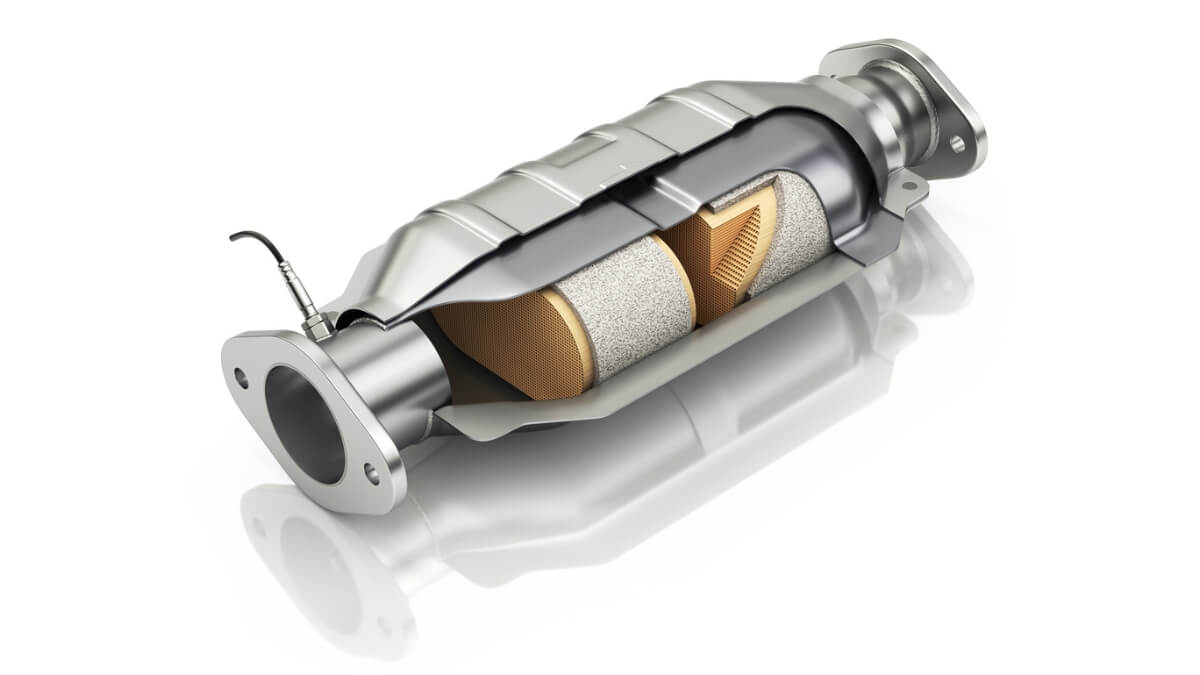
If you’re wondering what a catalytic converter is, then you’ve come to the right place! A catalytic converter is an essential component of the exhaust system on your vehicle that makes it friendlier for the environment. Every vehicle has at least one and most cars use two of these nowadays. They must be kept in good working condition to keep your engine running right and as clean as possible. In this article, we’ll cover exactly what a catalytic converter does, how you can tell if yours is going bad and what you should do if it's the case.
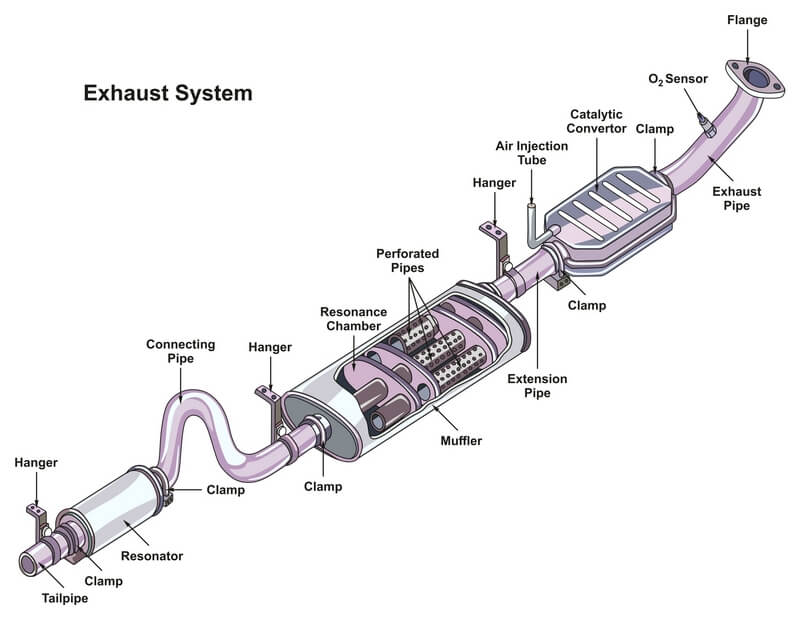
What a Catalytic Converter Does
A catalytic converter is a component of your vehicle’s exhaust system. Recent vehicles come equipped with two catalytic converters: on in the front, right after the exhaust manifold, and one near the middle of the car. Its entire purpose is to convert three dangerous substances resulting from the combustion of fuel into safer forms.
These three substances include carbon monoxide, hydrocarbon, and nitrogen oxide. Left unfiltered, these compounds are extremely harmful to the atmosphere and living creatures.
For example, a catalytic converter turns carbon monoxide into carbon dioxide, a much safer compound found naturally. Humans, in fact, exhale carbon dioxide when they breathe.
Hydrocarbon is partially converted into carbon dioxide too, but also water. Nitrogen oxide is broken down into oxygen and nitrogen, both relatively safely breathable compounds.
As you can see, a catalytic converter is quite essential for making your car more ecologically safe.
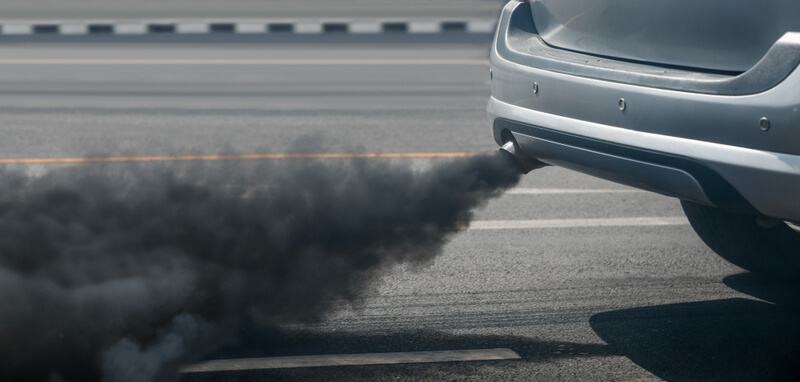
Signs of a Failing Catalytic Converter
You can typically tell when a catalytic converter is going bad by a decrease in performance, a foul odor, or if your vehicle is overheating.
When your converter is clogged, your vehicle will have a harder time accelerating. It may take you longer to get up to speed or you might need to push harder than usual on the gas pedal to accelerate.
You may also smell a foul odor that resembles rotten eggs. If this is accompanied by extremely dark clouds of smoke behind your car, this is generally a clear sign that your catalytic converter is going bad.
As a final warning sign, the exhaust portion of your vehicle can overheat. This is usually tough to notice because you won’t generally check for this. However, you should check to see if your exhaust is abnormally hot if you notice any other symptoms.
What Happens when a Catalytic Converter Goes Bad?
There are generally three different ways your converter can malfunction. This includes actual damage from a collision, contamination, and clogs.
If either of these occurs, your car will start to show one of the signs of a failing converter. If contamination is an issue, it will clog the exhaust up. This generally happens via leaded gas or leaking engine coolant.
If your converter gets too clogged, airflow will be impacted. This can cause your engine to stop altogether. Sluggish performance is usually the biggest giveaway.
A few other symptoms that could be a sign of a failing converter include a rattling noise coming from under your vehicle, your check engine light turning on, or car misfires. It is best to have a mechanic look at your car as soon as possible to verify it.
Can I Drive a Car with a Bad Catalytic Converter?
Technically yes, but you should get it looked at sooner rather than later. It really depends on how bad the condition is. A partially clogged catalytic converter will still allow your car to run. If it's your case, you should notice a loss of power and a decrease in fuel-efficiency.
However, a completely clogged catalytic will, in most cases, cause your engine to stall. The added restriction will also cause the catalytic converter to overheat incredibly and may even set your car on fire. I've personally encountered clogged converters that set both the interior carpet and the exhaust system insulator on fire on, at least, two occasions in my auto mechanic career. When a catalytic converter is totally obstructed, flooring the gas to try to reach the next auto repair shop might cause the converter to become so hot that you can see it glowing in the dark.
I don't have to mention that such a situation should be avoided at all costs. If you feel like your car has a hard time to pick up speed, the last thing to do is to push it even harder. Park the car at a safe place and call for a tow truck instead. The cost of having your car towed will still be less expensive than having to repair a fire under the carpet, damaging electrical wires and connectors at the same time.
Catalytic Converter Maintenance
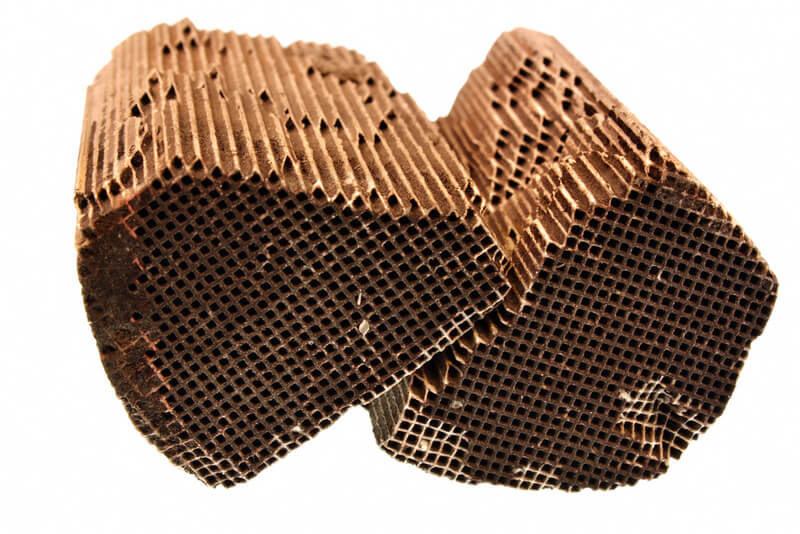
How often should I change my catalytic converter?
Assuming that it doesn’t sustain any physical damage, your converter should last 10 years and it shouldn't need to be replaced unless it becomes defectives. If other portions of your exhaust system are not working properly, that can reduce its lifetime and can lead to early catalytic converter clogging and/or failure.
If your converter is not yet 10 years old and isn’t too badly damaged, you might be able to unclog it yourself. Removing your catalytic converter is illegal, so you should try non-invasive methods that can clear it out without needing to remove it.
How to clear out clogs
First, you should lightly tap on your converter to ensure that there aren’t any loose pieces inside. If you can hear a rattling noise when shaking it, the element located inside is damaged and the catalytic converter will need to be replaced. If there aren’t any weird noise, then you can use a special mixture to try and clear out the clog.
You can do this by adding a converter cleaner into your fuel tank. You’ll then want to drive at high RPMs for 30 minutes to an hour on the freeway. This will get your exhaust system to try and burn out any clogs and will use the cleaner mixture too. Obviously, this technique only works if your catalytic converter is not completely clogged as it's unlikely that you'll be able to reach such speed then.
You should not try this if you suspect that there is oil in your catalytic converter. This can cause it to catch on fire. Additionally, make sure to keep an eye on the temperature of your coolant to verify that your car is not overheating.
One last thing to think about is that preventative maintenance is far more effective than remedial care. This means that you should be diligent about checking for any issues you notice with your vehicle. A common cause of converter clogs is driving for a long time with an engine burning too-rich. The excess fuel will end up clogging the catalytic converter's element at one point. There's no specific preventive maintenance to be done on a catalytic converter if only to keep the rest of the car in the best possible working condition.
Other Issues
If you notice any leaking fluids, you should get them quickly checked out to see where they are coming from and to stop the leak. Fluids leaking into the converter will quickly clog and contaminate it. This is particularly important with oil.
Regular oil changes are always a good idea, but this also gives you a chance to look at your old oil. You can identify issues like coolant in your oil, water contamination, and gas leaks. These are all significant problems that can lead to future problems with your catalytic converter.
Fixing a Broken Catalytic Converter

You will need to replace your converter if it is too clogged, damaged, or old for repair. Remember that it is illegal for you to remove your catalytic converter.
Even though catalytic converters are rated to last 10 years, this does not necessarily mean that you’ll need to replace it every 10 years. Good catalytic converters can last for the lifetime of your vehicle. It is other issues with your vehicle that shorten the lifespan of your converter that leads to early replacement.
What is the average cost to replace a catalytic converter?
Like any other vehicle parts, the cost of a new catalytic converter will vary depending on your vehicle make, model, and year. On the low end, you can expect a bill around $1,000 including labor. On the high end, don’t be surprised to pay $2,500 or more.
If you drive a common car like a Honda Accord or Civic, then your bill will be on the lower end. Driving a less common and specific model like a Saturn Vue will cause you to pay more. Expect around $1,500 as a rough estimate, with a wiggle room of $500 either way.
Closing Thoughts
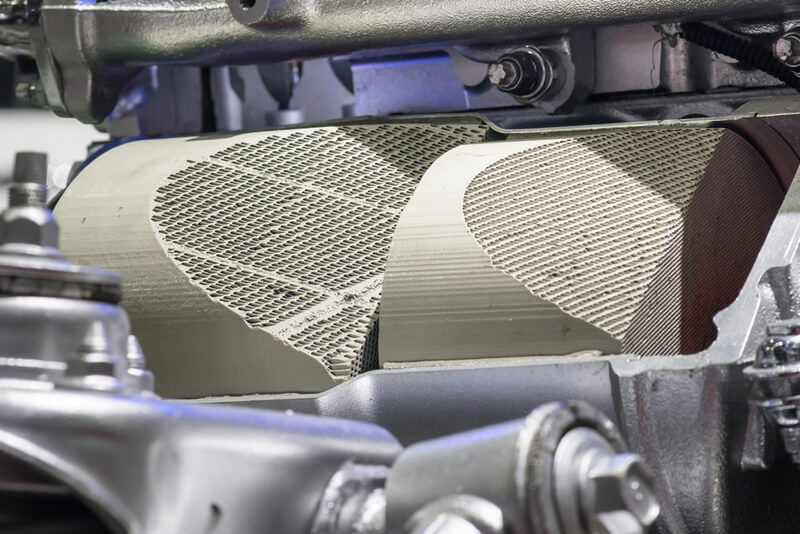
Your vehicle’s catalytic converter is an important part that makes it safer for the environment. Without one, carbon monoxide, hydrocarbon, and nitrogen oxide would freely flow into the atmosphere. A catalytic converter will convert these substances into safer compounds.
When a converter is failing, suspect a clog, contamination or physical damage. The easiest ways to identify this are by feeling sluggish acceleration, dark clouds of smoke behind your car, and a bad smell. Keep an eye out for misfires, rattling noises, or a check engine light as well.
Assuming other parts of your vehicle are fully functional, a catalytic converter should last for the lifetime of your vehicle. It is rated for 10 years, which is a good time to have it checked if you haven’t in a while.
In all cases, driving with a damaged catalytic converter will only lead to more expensive car problems in the end. If you suspect a faulty catalytic converter, have it checked and replaced as soon as possible. Keep in mind that preventive maintenance will always end up being less expensive than waiting until your car breaks down on the side of the road.
References
https://auto.howstuffworks.com/question66.htm
https://en.m.wikipedia.org/wiki/Catalytic_converter
https://itstillruns.com/long-drive-bad-catalytic-converter-6896829.html
https://mechanicbase.com/engine/clean-catalytic-converter-without-removing-it/
https://www.hotrod.com/articles/hppp-1304-9-tips-save-catalytic-converter/
https://carbrain.com/Blog/catalytic-converter-replacement-cost
